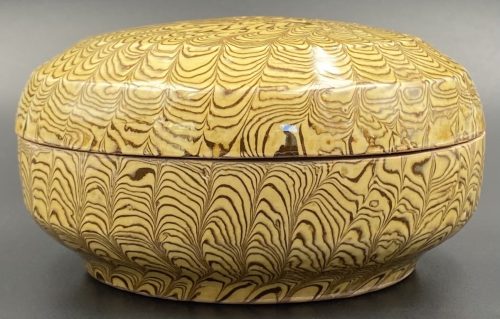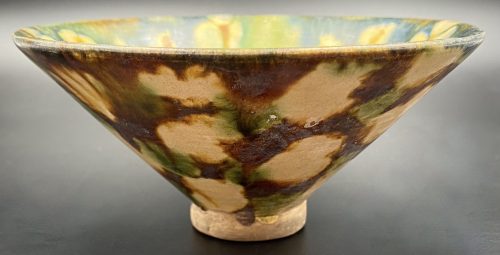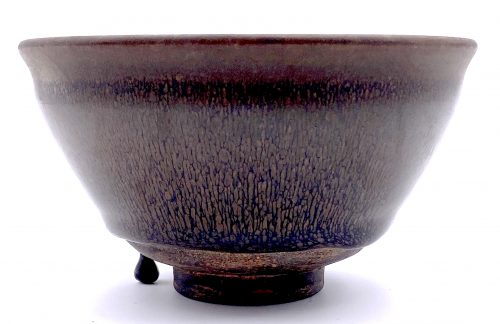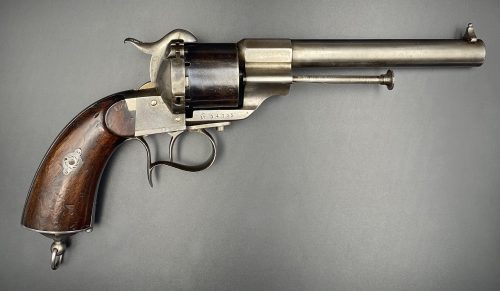-
 Press moulded round box with a cover made of yellow and brown marble clay, glazed with a clear glaze inside and outside. China, the Tang dynasty [唐朝] (618 – 907) Diameter: 11 cm; Height: 5.5 cm.
Press moulded round box with a cover made of yellow and brown marble clay, glazed with a clear glaze inside and outside. China, the Tang dynasty [唐朝] (618 – 907) Diameter: 11 cm; Height: 5.5 cm. -
 Footed conical bowl decorated with cream and brown splashes on green background inside, and cream and green splashes on the brown background outside. Diameter: 13.5 cm, H: 6.2 cm;
Footed conical bowl decorated with cream and brown splashes on green background inside, and cream and green splashes on the brown background outside. Diameter: 13.5 cm, H: 6.2 cm; -
 Iron tsuba of almost round form with a brass outlined circular opening (sukashi) in the bottom adorned with the Myriad Treasures [takaramono, 宝物] and winter motifs inlaid in cast brass (suemon-zōgan); hitsu-ana possibly cut later, both plugged with shakudo, nakaga-ana fitted with copper sekigane. According to Merrily Baird*) (2001), the symbolism of Myriad Treasures “is associated with the Seven Gods of Good Luck, who carry them in a sack”. Among the treasures, which are said to ensure prosperity, long life, and general good fortunes, are (reading clockwise from the top):
Iron tsuba of almost round form with a brass outlined circular opening (sukashi) in the bottom adorned with the Myriad Treasures [takaramono, 宝物] and winter motifs inlaid in cast brass (suemon-zōgan); hitsu-ana possibly cut later, both plugged with shakudo, nakaga-ana fitted with copper sekigane. According to Merrily Baird*) (2001), the symbolism of Myriad Treasures “is associated with the Seven Gods of Good Luck, who carry them in a sack”. Among the treasures, which are said to ensure prosperity, long life, and general good fortunes, are (reading clockwise from the top):- Sake set [shuki, 酒器], namely flask, ladle, and cups
- Cloves [choji, 丁子]
- Purse of inexhaustible reaches [kinchaku, 巾着]
- Magic mallet [kozuchi, 小槌]
- Key to the storehouse of the Gods [kagi, 鍵]
- Rhombus, or Lozenge (hosho, 方勝), with the second ideograph meaning victory.
- Sacred (or wish-granting) gem, or jewel [hōju, 宝珠]
- Hats of invisibility [kakuregasa, 隠れ笠]
-
 Thin iron tsuba of round form with design of family crests (mon) and arabesque (karakusa) in brass or copper inlay (suemon-zōgan) and occasional scattered brass dots or nail heads in ten-zōgan. Seppa-dai outlined with brass wire in the shape of a rope; kozuka-hitsu-ana outlined with scalloped brass wire. Rounded rim with iron bones (tekkotsu). The surface covered with lacquer (urushi). Ōnin school. Late Muromachi period, 16th century. Family crests on the face: 1:30: Two lines (double stripe) encircled (maruni futatsu biki). 4:30: Stylized clove (choji). 7:30: Divided rhombus, or four lozenges incorporated in one (wari-bishi); it is also called Takeda-bishi, the family crest of warrior Takeda Shingen (among the others). 10:00: Stylized Genji-mon (Genji kō-zu) or incense symbol. On the reverse: 2:00 - "Chinese cloud" not a crest. 5:00: Bit (Kutsuwa) 7:30: Number four in a fan (ōgi-san) 10:30: Two dots in a well frame (igeta).
Thin iron tsuba of round form with design of family crests (mon) and arabesque (karakusa) in brass or copper inlay (suemon-zōgan) and occasional scattered brass dots or nail heads in ten-zōgan. Seppa-dai outlined with brass wire in the shape of a rope; kozuka-hitsu-ana outlined with scalloped brass wire. Rounded rim with iron bones (tekkotsu). The surface covered with lacquer (urushi). Ōnin school. Late Muromachi period, 16th century. Family crests on the face: 1:30: Two lines (double stripe) encircled (maruni futatsu biki). 4:30: Stylized clove (choji). 7:30: Divided rhombus, or four lozenges incorporated in one (wari-bishi); it is also called Takeda-bishi, the family crest of warrior Takeda Shingen (among the others). 10:00: Stylized Genji-mon (Genji kō-zu) or incense symbol. On the reverse: 2:00 - "Chinese cloud" not a crest. 5:00: Bit (Kutsuwa) 7:30: Number four in a fan (ōgi-san) 10:30: Two dots in a well frame (igeta). -
 Iron tsuba of round form decorated with chrysanthemums, pine cones and needles, pampas grass, vines, cherry blossoms, and wild geese in brass inlay (suemon-zōgan) and pierced with designs of water clover (denjiso) and half bellflower (or karahana) to the left and to the right of nakago-ana as well as double bars above and below nakago-ana (possibly with the meaning of number 2 or ordinal 2nd). Most probably the sukashi elements here are the family crests (mon). Unsigned. Ōnin school. Muromachi period; 15th or 16th century. Height: 82.1 mm; Width: 80.9 mm; Thickness at seppa-dai: 2.4 mm NBTHK # 2003827: Tokubetsu Hozon Tosogu Kanteisho (特別保存刀装具鑑定書) - "Extraordinarily Worthy of Preservation".
Iron tsuba of round form decorated with chrysanthemums, pine cones and needles, pampas grass, vines, cherry blossoms, and wild geese in brass inlay (suemon-zōgan) and pierced with designs of water clover (denjiso) and half bellflower (or karahana) to the left and to the right of nakago-ana as well as double bars above and below nakago-ana (possibly with the meaning of number 2 or ordinal 2nd). Most probably the sukashi elements here are the family crests (mon). Unsigned. Ōnin school. Muromachi period; 15th or 16th century. Height: 82.1 mm; Width: 80.9 mm; Thickness at seppa-dai: 2.4 mm NBTHK # 2003827: Tokubetsu Hozon Tosogu Kanteisho (特別保存刀装具鑑定書) - "Extraordinarily Worthy of Preservation". -
 Iron tsuba of round form inlaid with brass, copper, and shakudō wire fastened to the surface with metal staples (mukade-zōgan); Scalloped brass inlay around the rim. Early Edo, 17th century. Height: 84.8 mm; Width 84.8 mm; Thickness at seppa-dai: 3.7 mm. Weight 161.6 g. Design is thought to resemble a centipede. "Centipede-like inlay (mukade zogan) of alternating iron and brass staples produce an appearance that was particularly favored by Takeda Shingen (1521-1573), one of the most powerful warlords of his time. The centipede is sacred to Bishamon (God of War) and especially propitious for a warrior. Shingen type, 16th century.” [The Peabody Museum collection of Japanese sword guards with selected pieces of sword furniture, by John D. Hamilton. Photographs by Mark Sexton. Salem, MA, 1975.] See also: http://varshavskycollection.com/shingen-tsuba/
Iron tsuba of round form inlaid with brass, copper, and shakudō wire fastened to the surface with metal staples (mukade-zōgan); Scalloped brass inlay around the rim. Early Edo, 17th century. Height: 84.8 mm; Width 84.8 mm; Thickness at seppa-dai: 3.7 mm. Weight 161.6 g. Design is thought to resemble a centipede. "Centipede-like inlay (mukade zogan) of alternating iron and brass staples produce an appearance that was particularly favored by Takeda Shingen (1521-1573), one of the most powerful warlords of his time. The centipede is sacred to Bishamon (God of War) and especially propitious for a warrior. Shingen type, 16th century.” [The Peabody Museum collection of Japanese sword guards with selected pieces of sword furniture, by John D. Hamilton. Photographs by Mark Sexton. Salem, MA, 1975.] See also: http://varshavskycollection.com/shingen-tsuba/ -
 Circular form tsuba made by a mirror-maker, i.e. kagamishi. Cast yamagane plate with design of six persimmons on their peduncles surrounded by leaves. Slightly raised rounded square rim. Hitsu-ana is brutally cut later in time. Copper sekigane. Early Muromachi period (1393-1457) or earlier. The inscription on the box reads: "Kamakura or Muromachi Period. Yamagane Tsuba". Dimensions: 81.9 x 81.6 mm; thickness at seppa-dai 2.8 - 3.0 mm, rim 3.4 mm.
Circular form tsuba made by a mirror-maker, i.e. kagamishi. Cast yamagane plate with design of six persimmons on their peduncles surrounded by leaves. Slightly raised rounded square rim. Hitsu-ana is brutally cut later in time. Copper sekigane. Early Muromachi period (1393-1457) or earlier. The inscription on the box reads: "Kamakura or Muromachi Period. Yamagane Tsuba". Dimensions: 81.9 x 81.6 mm; thickness at seppa-dai 2.8 - 3.0 mm, rim 3.4 mm. -
 Iron tsuba of mokko form decorated with brass flat inlay (hira-zōgan) all over on both sits and going over the rounded rim. Black patina, well-forged iron. Hitsu-ana outlined with brass inlay. Former owner's catalogue number in red paint reads 25-17-61. Gary D. Murtha provides detailed account of this type of tsuba in Japanese Sword Guards. Onin-Heianjo-Yoshiro book on pages 118-122. He calls this type of tsuba "Heianjo Mogusa Tsuba": "The term mogusa is commonly used for an inlay design that represents an aquatic weed, similar to a duck weed or sago plant, which is known to quickly invade and overtake bodies of water. [...] Perhaps the visual image has some cross-over meaning for samurai in that, like the plant, a small aggressive samurai force could conquer a larger foe/area." I tried to find any reference to "mogusa" in literature, - to no avail. Neither on the vastness of internet, including Wikipedia... I did find the "duckweed" (one word), but visually it has nothing to do with the pattern on tsuba. "Sago plant" probably stands for 'Sago palm", and there is some very distant reminiscence in the construction of the sago palm leaf and the said design of inlay, but I would not go that far. In the old catalogues, such as Naunton and Hawkshaw collections, this pattern as called "sea weed" and/or "conventional fir". I will stick to these descriptions, tested by the time, and leave the enigmatic "mogusa" alone. Obviously, this type of tsuba has transformed into Yoshirō tsuba, both in Kaga province and Bizen province. Momoyama period (ca. 1660). Dimensions: 74.5 x 73.7 x 4.4 mm.
Iron tsuba of mokko form decorated with brass flat inlay (hira-zōgan) all over on both sits and going over the rounded rim. Black patina, well-forged iron. Hitsu-ana outlined with brass inlay. Former owner's catalogue number in red paint reads 25-17-61. Gary D. Murtha provides detailed account of this type of tsuba in Japanese Sword Guards. Onin-Heianjo-Yoshiro book on pages 118-122. He calls this type of tsuba "Heianjo Mogusa Tsuba": "The term mogusa is commonly used for an inlay design that represents an aquatic weed, similar to a duck weed or sago plant, which is known to quickly invade and overtake bodies of water. [...] Perhaps the visual image has some cross-over meaning for samurai in that, like the plant, a small aggressive samurai force could conquer a larger foe/area." I tried to find any reference to "mogusa" in literature, - to no avail. Neither on the vastness of internet, including Wikipedia... I did find the "duckweed" (one word), but visually it has nothing to do with the pattern on tsuba. "Sago plant" probably stands for 'Sago palm", and there is some very distant reminiscence in the construction of the sago palm leaf and the said design of inlay, but I would not go that far. In the old catalogues, such as Naunton and Hawkshaw collections, this pattern as called "sea weed" and/or "conventional fir". I will stick to these descriptions, tested by the time, and leave the enigmatic "mogusa" alone. Obviously, this type of tsuba has transformed into Yoshirō tsuba, both in Kaga province and Bizen province. Momoyama period (ca. 1660). Dimensions: 74.5 x 73.7 x 4.4 mm. -

Thin iron tsuba of round form pierced with six three-leaf wood sorrels (katabami) in ko-sukashi and inlaid with brass decoration along the rim. Kozuka-hitsu-ana probably cut at a later date.
Late Muromachi or Momoyama period, 16th century. Dimensions: 78.0 x 77.7 x 2.5 mm. -
 Iron tsuba of quatrefoil form with design of bamboo stems and leaves in openwork (sukashi) decorated with carving (kebori) . Copper sekigane. Early Edo period, late 17th century (Kanbun / Enppo era). First generation Kanshiro of Nishigaki school in Higo Province died in the sixth year of Genroku, 1693, at the age of 81). Height: 74.4 mm; Width: 74.2 mm; Centre thickness: 4.9 mm. Rounded rim. The design was quite popular among the Higo masters.
Iron tsuba of quatrefoil form with design of bamboo stems and leaves in openwork (sukashi) decorated with carving (kebori) . Copper sekigane. Early Edo period, late 17th century (Kanbun / Enppo era). First generation Kanshiro of Nishigaki school in Higo Province died in the sixth year of Genroku, 1693, at the age of 81). Height: 74.4 mm; Width: 74.2 mm; Centre thickness: 4.9 mm. Rounded rim. The design was quite popular among the Higo masters.
Kanshiro III, early 18th century (Sasano 1994 №267)

Matashichi I, late 17th century (Sasano 1994 №270)
The design of my tsuba closely resembles the one at the last example (Sasano 1994 №280), however, the form (mine is quatrefoil) and the execution (strength) are very different, which result in a very different spirit of my piece.
Shigemitsu II, early 18th century (Sasano 1994 №280)
-
 Brown bowl with golden-brown streaks on a black ground, mouth with a curved profile. A drop of glaze hanging in support. Base unglazed. In a wooden box. China, the Song dynasty [宋朝] (960 – 1279). Diameter: 12.5 cm; Height: 7 cm.
Brown bowl with golden-brown streaks on a black ground, mouth with a curved profile. A drop of glaze hanging in support. Base unglazed. In a wooden box. China, the Song dynasty [宋朝] (960 – 1279). Diameter: 12.5 cm; Height: 7 cm. -

Six shot 11-millimetre Lefaucheux Brevete M-1854 single-action pin-fire revolver, serial #34755. French large calibre revolver features octagon to round barrel, non-fluted cylinder, walnut grips with the heavy pommel.
Manufactured in Paris.
Dimensions: L: 29.5 cm; H: 15.5 cm; Barrel: 16 cm.


